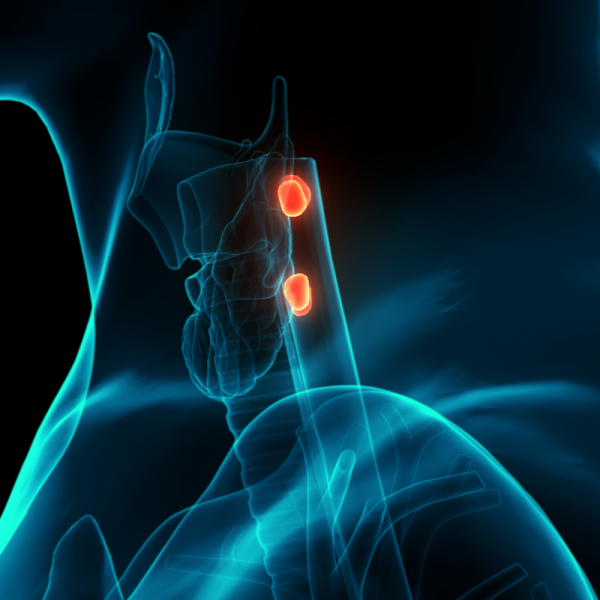
What is parathyroid cancer?
Parathyroid cancer refers to the development of a malignant tumour, which is usually triggered by primary hyperparathyroidism (pHPT) and can be diagnosed by its symptoms. Parathyroid cancer occurs in less than 1 per cent of all people affected by pHPT and develops more frequently than average in middle-aged adults. Both men and women are equally likely to develop parathyroid cancer.
Parathyroid cancer causes an increase in the level of calcium in the blood. Since parathyroid cancer is considered an extremely rare disease, there are still no treatment guidelines or experience in dealing with the disease. This often makes it difficult to treat the disease as soon as possible and means that parathyroid cancer has a rather poor prognosis.
What causes parathyroid cancer?
The causes of parathyroid cancer have not yet been adequately researched. However, doctors assume that tertiary hyperparathyroidism, which can occur in dialysis patients, but also radiation therapy in the head and neck area can cause and trigger the development of parathyroid cancer.
What are the symptoms of parathyroid cancer?
Parathyroid cancer can trigger an overfunction of the parathyroid gland, a so-called hyperparathyroidism. In this case, there is an overproduction of the parathyroid hormone (parathormone), which is normally supposed to regulate the calcium level in the body. The mineral calcium is responsible for the correct functioning of nerves and muscles in the body. If calcium levels are elevated, the following symptoms may occur:
- constant symptoms of exhaustion, listlessness, impaired concentration and/or memory, and depressive tendencies,
- increased excretion of urine, whereby the patient also complains of an increased feeling of thirst,
- unwanted weight loss with simultaneous loss of appetite, constipation and/or vomiting,
- Calcification of the kidneys and/or formation of kidney stones,
- cramping pain in the kidney region,
- accelerated heartbeat and/or heart palpitations,
- High blood pressure,
- Back and/or joint pain,
- increased bone loss (osteoporosis) with spontaneous bone fractures, which often occurs in advanced disease,
- life-threatening crises, which can be triggered by kidney failure or even coma, if the calcium level is severely elevated.
How is parathyroid cancer diagnosed?
To diagnose parathyroid cancer, the parameters in the patient's blood are checked in the laboratory. If the parathyroid hormone, parathormone (PTH), as well as the serum and urine calcium and the urine phosphate are found to be elevated and the serum phosphate is found to be decreased, the suspicion of parathyroid cancer hardens. Within an intraoperative diagnosis, it is then checked whether the tumour has a firm consistency or has already grown into the surrounding tissue. The latter is indicative of parathyroid cancer.
When diagnosing parathyroid cancer, it is often difficult to distinguish it from a benign adenoma of the parathyroid glands. An unequivocal diagnosis is only possible if vascular invasion and infiltration of the parathyroid carcinoma into the neighbouring tissue have already taken place. Within an ultrasound examination (sonography), parathyroid cancer appears as an echo-poor tumour that is significantly larger than a benign adenoma of the parathyroid gland.
How is parathyroid cancer treated?
The first form of treatment for parathyroid cancer is the complete surgical removal of the tumour, if necessary including the affected thyroid lobe (parathyroidectomy) and any affected lymph nodes. After the operation, the patient usually has to stay in hospital for between 3 and 4 days. Some patients may complain of difficulty swallowing after the operation. Nevertheless, regular eating can usually be started immediately. Before the patient is discharged from the hospital, the laboratory parameters are checked again. Thanks to self-dissolving sutures, there is no need to remove the sutures. Although few patients complain of discomfort after parathyroid surgery, physical exertion should be avoided immediately, i.e. for the two weeks following the operation. Approximately one month after the operation, the first follow-up is scheduled. For this purpose, the laboratory values will be determined again, which can be done by the dermatologist.
If surgery is not possible, medication is used to try to lower the serum calcium, for example by administering calcimimetics (Cincacalcet). In addition, the patient should eliminate urinary substances by excessive drinking in order to try to regulate the water, electrolyte and acid-base balance (forced diuresis). If the case of parathyroid cancer is asymptomatic, the tumour can initially only be observed through regular check-ups.
What complications can occur?
If the parathyroid gland is completely removed or injured during surgery, this can lead to low calcium levels in the blood. A low calcium level can cause the following symptoms:
- Sensory disturbances or tingling in the limbs, but also around the mouth area,
- Muscle cramps.
To compensate for the low calcium content in the blood, it is sufficient to take one calcium tablet a day. Vitamin D can also be administered. The intake can then be stopped when the serum calcium level is again below the normal range. The majority of patients recover spontaneously within a few days or weeks after surgery.
What is the prognosis for parathyroid cancer?
If parathyroid carcinoma is diagnosed early and can be surgically removed, the chances of recovery are generally good. However, even if the tumour is completely removed, it is still possible for metastases to form later or for a new tumour to develop again after many years of initial therapy. The recurrence rate is 50 percent. For a positive prognosis, it is fundamentally important that the symptoms of hypercalcaemia are contained and made controllable, which is why the prognosis of parathyroid carcinoma is usually only made after surgery. The 10-year survival rate is between 60 and 70 percent.
